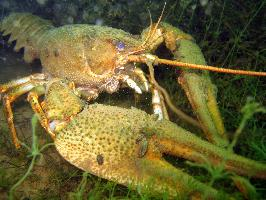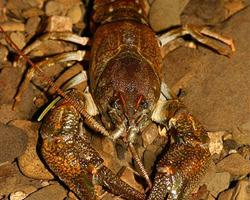
Poids et mesures
| Longueur | de 6 à 9 cm |
|---|
Statut de conservation
| Menacé |
Description de l'animal
The Signal Crayfish (Pacifastacus leniusculus) is a noteworthy species of freshwater crayfish native to the western United States and Canada. Recognized for its significant ecological impact and economic value, this species has also gained notoriety for its invasive status in various parts of the world, particularly in European waterways. The Signal Crayfish is characterized by a robust and versatile physique, adapted perfectly to a variety of freshwater habitats.Physical Description:
The Signal Crayfish is distinguishable by its sturdy body, which can reach up to 16-18 centimeters (6-7 inches) in length, making it one of the larger crayfish species. Its exoskeleton displays a range of colors, from reddish-brown to a darker greenish-brown, providing camouflage against the muddy and rocky riverbeds it inhabits. One of the most distinctive features of this species is the presence of bright white to bluish spots on the sides of its claw joints, which resemble signals—hence its common name. The claws themselves are quite large and powerful, equipped with a set of sharp pincers used for defense, feeding, and manipulating their environment.
Habitat and Distribution:
Originally found in freshwater streams, rivers, and lakes across the northwestern United States and British Columbia, Canada, the Signal Crayfish has been introduced to a variety of new locales, including Europe and Japan. In its natural habitat, it prefers areas with abundant hiding spots such as rocks, logs, and dense vegetation, which provide shelter from predators and opportunities to ambush prey. The adaptability of the Signal Crayfish to different environmental conditions has facilitated its spread beyond its native range, often to the detriment of local ecosystems.
Diet and Behavior:
The diet of the Signal Crayfish is omnivorous and highly opportunistic. It feeds on a wide array of food sources, including plants, detritus, insects, snails, and small fish. This dietary flexibility helps it thrive in diverse environments. Signal Crayfish are also known for their nocturnal activity patterns, spending the day hidden under rocks or buried in sediment, emerging at night to feed.
Ecological Impact:
While the Signal Crayfish plays a crucial role in its native ecosystems, serving as both predator and prey, its introduction to non-native habitats has caused significant ecological disruptions. In Europe, for example, it has outcompeted and displaced indigenous crayfish species, leading to their decline. The Signal Crayfish is also a carrier of the crayfish plague (Aphanomyces astaci), a fungal disease lethal to native European crayfish but to which the Signal Crayfish is resistant. This has further exacerbated its impact on native biodiversity.
Conservation and Economic Importance:
In its native range, the Signal Crayfish is considered an important species for both ecological balance and as a resource for commercial and recreational fishing. However, efforts are ongoing in areas where it has been introduced to manage its population and mitigate its negative impacts on local ecosystems and native species. Conservation strategies include habitat restoration, the introduction of barriers to prevent spread, and public education on the dangers of releasing non-native species into the wild.
In summary, the Signal Crayfish is a fascinating species with a complex role in both its native and introduced environments. Its ability to adapt and thrive in diverse conditions has made it a subject of interest for ecologists, conservationists, and fishermen alike. However, the challenges associated with its invasive status underscore the importance of careful management and conservation efforts to preserve biodiversity and maintain ecological balance.
Animaux similaires
Nouvelles photos d'animaux
Top 10 des animaux
- Dolphin gull (Leucophaeus scoresbii)
- Diana monkey (Cercopithecus diana)
- Moustached guenon (Cercopithecus cephus)
- Galápagos tortoise (Geochelone nigra complex)
- Stone loach (Barbatula barbatula)
- Japanese macaque (Macaca fuscata)
- Russian tortoise (Testudo horsfieldii)
- Greek tortoise (Testudo graeca)
- Common flying dragon (Draco volans)
- Vendace (Coregonus albula)


